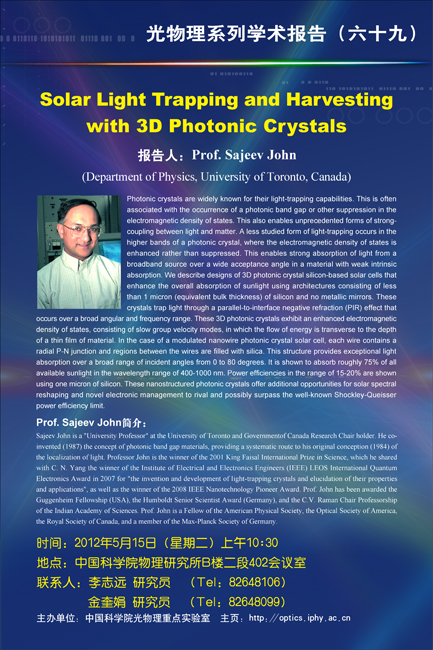题目:Solar Light Trapping and Harvesting with 3D Photonic Crystals
报告人:Prof. Sajeev John (Department of Physics, University of Toronto, Canada)
Abstract:
Photonic crystals are widely known for their light-trapping capabilities. This is often associated with the occurrence of a photonic band gap or other suppression in the electromagnetic density of states. This also enables unprecedented forms of strong-coupling between light and matter. A less studied form of light-trapping occurs in the higher bands of a photonic crystal, where the electromagnetic density of states is enhanced rather than suppressed. This enables strong absorption of light from a broadband source over a wide acceptance angle in a material with weak intrinsic absorption. We describe designs of 3D photonic crystal silicon-based solar cells that enhance the overall absorption of sunlight using architectures consisting of less than 1 micron (equivalent bulk thickness) of silicon and no metallic mirrors. These crystals trap light through a parallel-to-interface negative refraction (PIR) effect that occurs over a broad angular and frequency range. These 3D photonic crystals exhibit an enhanced electromagnetic density of states, consisting of slow group velocity modes, in which the flow of energy is transverse to the depth of a thin film of material. In the case of a modulated nanowire photonic crystal solar cell, each wire contains a radial P-N junction and regions between the wires are filled with silica. This structure provides exceptional light absorption over a broad range of incident angles from 0 to 80 degrees. It is shown to absorb roughly 75% of all available sunlight in the wavelength range of 400-1000 nm. Power efficiencies in the range of 15-20% are shown using one micron of silicon. These nanostructured photonic crystals offer additional opportunities for solar spectral reshaping and novel electronic management to rival and possibly surpass the well-known Shockley-Queisser power efficiency limit.
Prof. Sajeev John简介:
Sajeev John is a “University Professor” at the University of Toronto and Governmentof Canada Research Chair holder. He co-invented (1987) the concept of photonic band gap materials, providing a systematic route to his original conception (1984) of the localization of light. Professor John is the winner of the 2001 King Faisal International Prize in Science, which he shared with C. N. Yang,the winner of the Institute of Electrical and Electronics Engineers (IEEE) LEOS International Quantum Electronics Award in 2007 for “the invention and development of light-trapping crystals and elucidation of their properties and applications”, as well as the winner of the 2008 IEEE Nanotechnology Pioneer Award. Prof. John has been awarded the Guggenheim Fellowship (USA), the Humboldt Senior Scientist Award (Germany), and the C.V. Raman Chair Professorship of the Indian Academy of Sciences. Prof. John is a Fellow of the American Physical Society, the Optical Society of America, the Royal Society of Canada, and a member of the Max-Planck Society of Germany.
时间:2012年5月15日(星期二)上午10:30
地点:中国科学院物理研究所B楼二段402会议室
联系人:李志远研究员(Tel:82648106)
金奎娟研究员(Tel:82648099)
主办单位:中国科学院光物理重点实验室








